Germ Disc, Gastrulation & Neurulation: Fortion of Organs
Germ Disc Formation (Early Embryonic Development)
After fertilization and cleavage, the embryo, now a blastocyst, undergoes profound organizational changes. It remodels itself from a sphere into a flattened, two-layered structure known as the Bilaminar Germ Disc. This process is crucial as it sets the stage for gastrulation, where the three primary germ layers will form.

1. From Blastocyst to Bilaminar Germ Disc
This transformation begins around Day 8 post-fertilization, as the Inner Cell Mass (ICM) differentiates.
Epiblast (Dorsal/Upper Layer)
A layer of columnar cells facing the developing amniotic cavity. Crucially, all three primary germ layers of the embryo will eventually originate from the epiblast.
Hypoblast (Ventral/Lower Layer)
A layer of cuboidal cells facing the blastocoel. It primarily contributes to extraembryonic membranes, particularly the yolk sac.
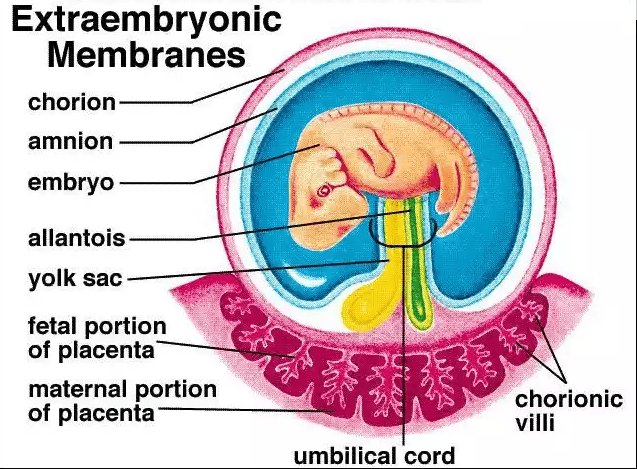
2. Formation of Extraembryonic Structures
In parallel with the germ disc formation, structures vital for supporting the embryo begin to develop.
Amniotic Cavity
A new fluid-filled space that appears within the epiblast, enclosed by a thin membrane called the amnion. It will eventually surround the entire embryo.
Primary Umbilical Vesicle (Yolk Sac)
Forms when hypoblast cells line the blastocoel. In humans, it plays roles in early blood cell formation and nutrient transfer.
Extraembryonic Mesoderm & Coelom
A new layer of mesoderm forms between the yolk sac/amnion and the trophoblast. A large cavity, the chorionic cavity (or coelom), then forms within this mesoderm, suspending the embryo by a connecting stalk.
3. Summary of Key Structures by End of Week 2
By day 14, the embryo, though tiny, has established a clear organization, suspended within the chorionic cavity:
- Bilaminar Germ Disc: Composed of the dorsal epiblast and ventral hypoblast.
- Amniotic Cavity: Located dorsal to the epiblast.
- Yolk Sac: Located ventral to the hypoblast.
- Connecting Stalk: A thick column of extraembryonic mesoderm that connects the germ disc to the outer chorion and will become the umbilical cord.
Clinical Significance
This highly sensitive period is critical for assessing early embryonic viability. Disruptions during germ disc formation can lead to severe birth defects, and this is when issues like ectopic pregnancies become apparent.
4. Transition to Gastrulation
The formation of the bilaminar germ disc is the final preparatory step before gastrulation begins in week 3. During gastrulation, cells from the epiblast will migrate inward through the primitive streak to form the three definitive germ layers (ectoderm, mesoderm, and endoderm) that will give rise to the entire body.
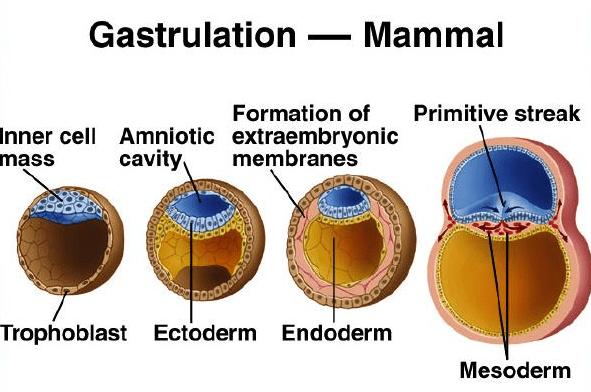
Gastrulation: Formation of Germ Layers and Body Axis
Gastrulation is a highly complex and critical developmental process that involves the dramatic reorganization and movement of embryonic cells. This process transforms the simple, two-layered bilaminar disc into a three-layered structure.
These three layers, known as the primary germ layers, are the foundational tissues from which all organs and tissues of the body will ultimately develop. In humans, gastrulation occurs around week 3 of embryonic development, after the blastocyst has successfully implanted.
Key Events of Gastrulation
Gastrulation is initiated by two fundamental events that establish the blueprint for the developing embryo.
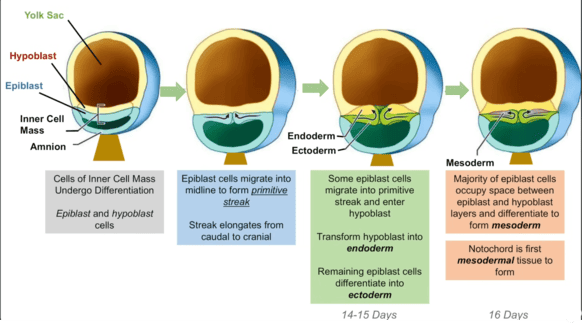
1. Formation of the Primitive Streak
A thickened line of cells forms on the dorsal surface of the epiblast. The primitive streak is profoundly important as it establishes all major body axes: anterior-posterior (head-tail), dorsal-ventral (back-belly), and medial-lateral.
2. Cell Migration & Invagination
Epiblast cells migrate towards the primitive streak and then "dive" inward in a process called invagination. It is this inward migration and subsequent differentiation that forms the new germ layers.

The Three Primary Germ Layers
As cells invaginate and migrate, they arrange themselves into three distinct layers, each with a specific developmental fate.
Ectoderm (Outer Layer)
Formed from the remaining cells of the epiblast that do not invaginate.
Future Structures:
- Nervous System (brain, spinal cord, nerves)
- Epidermis of Skin (including hair and nails)
- Sensory Organs (eyes, ears)
Mesoderm (Middle Layer)
Formed from the cells that invaginate and migrate to lie between the epiblast and the newly formed endoderm.
Future Structures:
- Muscles, Bones, and Cartilage
- Circulatory System (heart, blood, vessels)
- Kidneys and Reproductive Organs
Endoderm (Inner Layer)
Formed from the first cells that invaginate and displace the original hypoblast layer.
Future Structures:
- Lining of the Digestive Tract (and associated glands like the liver and pancreas)
- Lining of the Respiratory System (lungs)
- Lining of the Bladder
Organogenesis: From Germ Layers to Organs
Organogenesis is the dynamic developmental process where the three primary germ layers transform into specialized tissues and functional organs. This highly coordinated period begins around the end of week 3 and continues intensely through week 8, by which time all major organ systems have begun to form.
I. Development from the Ectoderm (Outer Layer)
The ectoderm gives rise to structures that maintain contact with the outside world.
Neurulation (Formation of the Nervous System)
The notochord (from the mesoderm) induces the overlying ectoderm to form the neural plate, which folds into the neural tube. This tube becomes the brain and spinal cord (CNS).
Neural Crest Cells break off during this process to form the peripheral nervous system, pigment cells, and parts of the face, skull, and heart.
Epidermal Ectoderm
The remaining ectoderm forms the epidermis and its derivatives, including: hair, nails, sweat glands, mammary glands, tooth enamel, and the lens of the eye.
II. Development from the Mesoderm (Middle Layer)
The mesoderm gives rise to structures that support and move the body, and circulate fluids.
Paraxial Mesoderm (forms Somites)
- Sclerotome: Vertebrae and ribs (skeleton).
- Myotome: Skeletal muscles.
- Dermatome: Dermis of the skin.
Intermediate Mesoderm
Forms the urogenital system: kidneys, gonads (ovaries/testes), and their associated ducts.
Lateral Plate Mesoderm
Forms the body cavities, connective tissues of the body wall and limbs, smooth muscle of organs, and the entire circulatory system (heart, blood vessels, blood cells).
III. Development from the Endoderm (Inner Layer)
The endoderm primarily forms the epithelial lining of internal structures.
Gut Tube & Respiratory System
The endoderm folds to form a tube, giving rise to the epithelial lining of the entire digestive tract (pharynx to large intestine) and the respiratory system (trachea, bronchi, lungs).
Associated Glands & Organs
Forms the functional tissues of the liver, pancreas, gallbladder, thyroid, parathyroid, and thymus, as well as the lining of the urinary bladder.

Neurulation: The Foundation of the Nervous System
Neurulation is the pivotal process by which the neural plate folds and fuses to form the neural tube, the embryonic precursor to the central nervous system (CNS)—the brain and the spinal cord. This is one of the first major events of organogenesis.
This process begins during the third week of development (around day 18) and is completed by the end of the fourth week (around day 28). It occurs in the dorsal ectoderm, directly above the notochord.
Key Players and Precursors
Notochord (from Mesoderm)
The master conductor. This rod-like structure secretes signaling molecules that act as neural inducers.
Ectoderm
The outermost germ layer that responds to the notochord's signals, differentiating into the nervous system and skin.
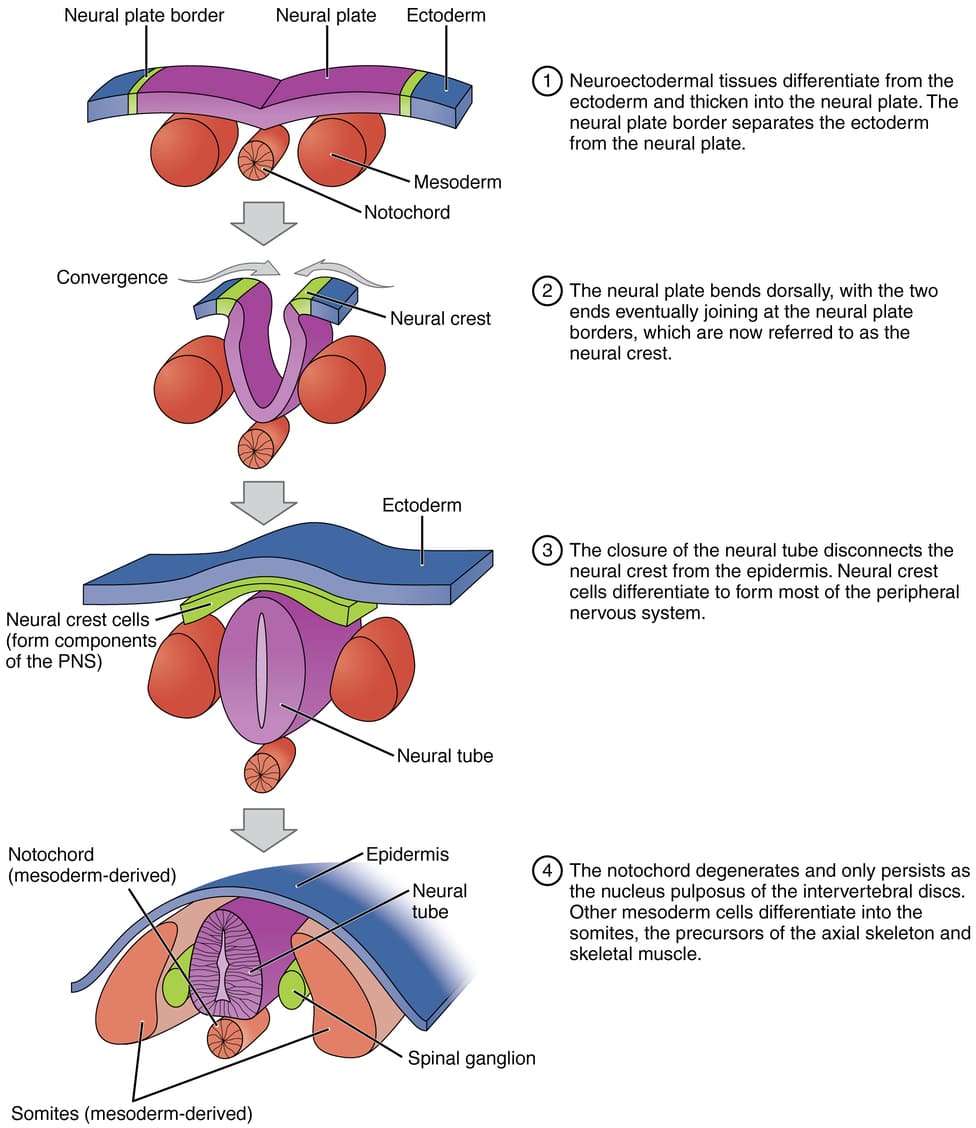
Stages of Neurulation
Neurulation is divided into two main phases, with primary neurulation forming the majority of the CNS.
1. Primary Neurulation
a. Formation of the Neural Plate (Day 18)
The notochord induces the overlying ectoderm to thicken and flatten, forming an elongated structure called the neural plate. The cells of this plate are now called neuroectoderm.
b. Formation of Neural Groove & Folds (Day 19-20)
The lateral edges of the neural plate elevate to form neural folds, while the central region sinks to create the neural groove. Hinge points form, causing the plate to bend inward.
c. Fusion of Neural Folds (Day 20-22)
The neural folds move towards the midline and begin to fuse, starting in the future cervical (neck) region. This fusion proceeds in both directions, like a zipper.
d. Formation of the Neural Tube & Neural Crest
As the folds fuse, the neural tube is pinched off from the surface ectoderm, which then fuses above it to become the epidermis. At the crests of the fusing folds, a unique population of neural crest cells delaminates and begins to migrate.
e. Closure of Neuropores
The open ends of the neural tube, the neuropores, are the last to close. The anterior (cranial) neuropore closes around day 25, and the posterior (caudal) neuropore closes around day 28.
2. Secondary Neurulation
While primary neurulation forms most of the CNS, the very caudal (tail end) part of the spinal cord is formed by a different process. This involves the condensation of mesenchyme cells in the tail bud, which then cavitate and fuse with the primary neural tube.
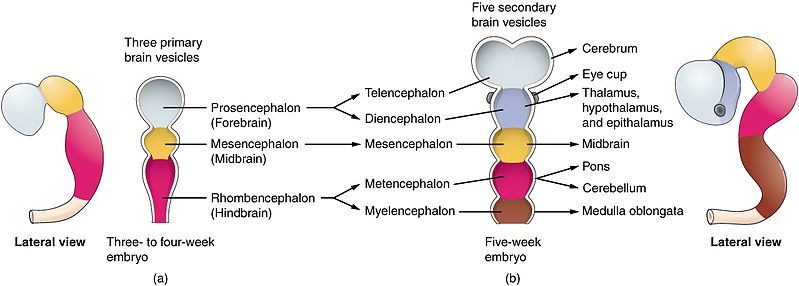
Derivatives of the Neural Tube
The neural tube, the primary structure formed during neurulation, differentiates into the entire Central Nervous System (CNS).
Brain
The anterior (cranial) part of the tube undergoes significant expansions to form the primary brain vesicles, which further differentiate into all adult brain structures (cerebrum, cerebellum, brainstem, etc.).
Spinal Cord
The posterior (caudal) part of the neural tube forms the spinal cord.
Neural Canal
The hollow lumen inside the tube becomes the ventricular system of the brain and the central canal of the spinal cord, responsible for circulating cerebrospinal fluid (CSF).
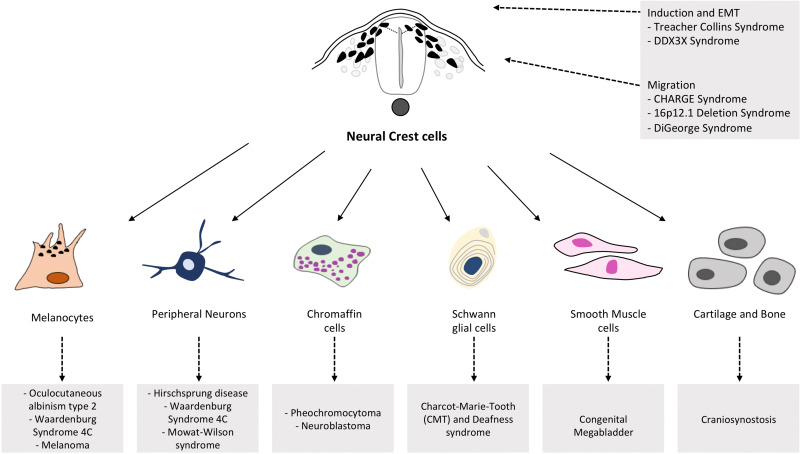
Derivatives of the Neural Crest Cells
Neural crest cells are often called the "fourth germ layer" due to their remarkable migratory abilities and the vast array of diverse tissues they form. After delaminating from the neural folds, they travel extensively throughout the embryo.
Peripheral Nervous System (PNS)
- Sensory & Autonomic Neurons
- Schwann Cells
Endocrine & Pigment
- Adrenal Medulla
- Melanocytes (pigment cells)
Craniofacial Structures
- Bones & cartilage of face/skull
- Dentin of teeth
Cardiac Development
- Outflow tract of the heart
Clinical Significance: Neural Tube Defects (NTDs)
Errors in neural tube closure are among the most common congenital malformations and lead to severe conditions.
Anencephaly
Failure of the anterior neuropore to close, resulting in the absence of a major portion of the brain and skull. This condition is incompatible with life.
Spina Bifida
Failure of the posterior neuropore to close, leading to defects in the vertebral column, often with protrusion of the spinal cord and/or meninges. Severity varies greatly.
Prevention
Folic acid supplementation taken by the mother before conception and during early pregnancy can significantly reduce the risk of NTDs by up to 70%.
Test Your Knowledge
Check your understanding of the concepts covered in this post.
1. The bilaminar germ disc consists of which two primary layers?
- Ectoderm and Endoderm
- Epiblast and Hypoblast
- Trophoblast and Embryoblast
- Mesoderm and Ectoderm
2. Which of the following structures is entirely derived from the epiblast during gastrulation?
- Endoderm
- Mesoderm
- Ectoderm
- All of the above
3. The process by which the bilaminar germ disc transforms into a trilaminar germ disc with three distinct germ layers is known as:
- Cleavage
- Implantation
- Gastrulation
- Organogenesis
4. The primitive streak, a crucial structure for gastrulation, is formed from the proliferation and migration of cells from the:
- Hypoblast
- Epiblast
- Trophoblast
- Extraembryonic mesoderm
5. Which germ layer gives rise to the nervous system and the epidermis of the skin?
- Ectoderm
- Mesoderm
- Endoderm
- Hypoblast
6. The notochord, a transient but essential structure, induces the overlying ectoderm to thicken and form the neural plate. This inductive process is a key step in:
- Gastrulation
- Organogenesis
- Neurulation
- Cleavage
7. Closure of the neural tube typically begins in the __________ region of the embryo and proceeds bidirectionally.
- Cranial (head)
- Caudal (tail)
- Cervical (neck)
- Lumbar (lower back)
8. Derivatives of the neural crest cells include all of the following EXCEPT:
- Sensory neurons (dorsal root ganglia)
- Melanocytes (pigment cells)
- Adrenal medulla cells
- Skeletal muscle cells
9. Organogenesis, the process of organ and body systems formation, primarily occurs during which period of embryonic development?
- Week 1-2
- Week 3-8
- Week 9-birth
- After birth
10. A failure of the caudal (posterior) neuropore to close during neurulation can lead to which birth defect?
- Anencephaly
- Spina bifida
- Cleft lip
- Heart defects
11. The two components of the bilaminar germ disc are the epiblast and the _____________.
12. During gastrulation, the first cells to migrate through the primitive streak replace the hypoblast to form the definitive _____________.
13. The formation of the neural plate, neural folds, and their subsequent fusion to form the neural tube is known as _____________.
14. The mesenchymal cells that migrate from the neural folds and contribute to a wide variety of tissues throughout the body are called _____________.
15. The germ layer responsible for forming the lining of the gastrointestinal tract and respiratory system is the _____________.
Quiz Complete!
Your Score:
0%
0 / 0 correct